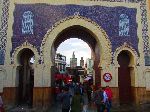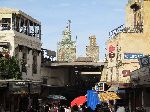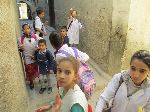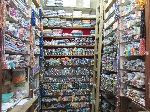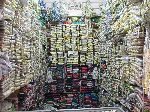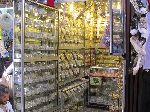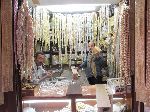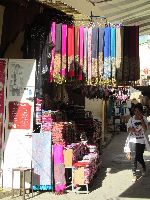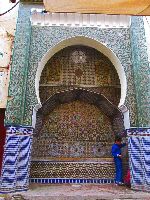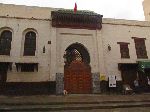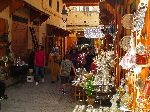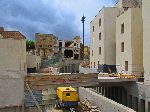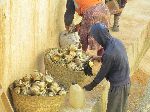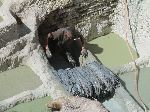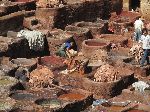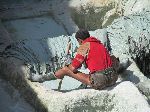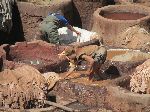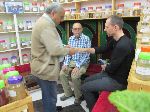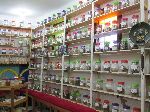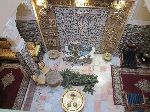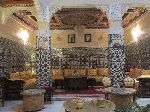|
Morocco:
West Atlas Bicycle Africa / Ibike Tours |
|||
 |
Fes: "Mecca of the West" and "Athens of Africa" | ||
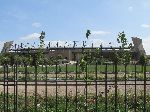 |
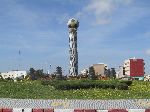
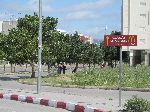 You
need to be patient to making a judgment as you enter Fez. It has become a large
sprawling city. The "outer donut" is very much like the newer
development of other Moroccan cities. One route into the city took you past the
football / soccer stadium and a soccer ball sculpture in a traffic circle. You
need to be patient to making a judgment as you enter Fez. It has become a large
sprawling city. The "outer donut" is very much like the newer
development of other Moroccan cities. One route into the city took you past the
football / soccer stadium and a soccer ball sculpture in a traffic circle. |
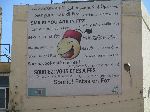 |
|
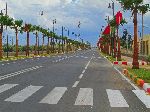 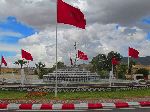 Entering
from another direction you pass a Royal Palace (which can't be photographed),
the pass down a flag-lined boulevard, which leads to a flag festooned traffic
circle. Entering
from another direction you pass a Royal Palace (which can't be photographed),
the pass down a flag-lined boulevard, which leads to a flag festooned traffic
circle.This is still miles from the city center. A section of the connecting road has a stripped bike lane and designated horse-cart track (far right). |
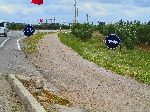 |
||
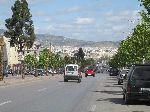 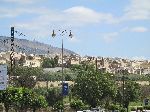 Miles
of main streets are fronted by commercial activities and services businesses,
and back streets are predominately residential. In a very suburban way, a
sign-board announces the presence of a nearby McDonalds restaurant. Miles
of main streets are fronted by commercial activities and services businesses,
and back streets are predominately residential. In a very suburban way, a
sign-board announces the presence of a nearby McDonalds restaurant. |
|||
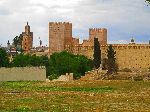 |
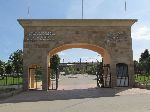 The
outskirts of Fez don't provide a clue to the richness and craftsmanship of its
core. The
outskirts of Fez don't provide a clue to the richness and craftsmanship of its
core.Historically, the city was confined by the city wall. Today, the ramparts that can be found are modern reconstructions. |
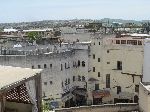 |
|
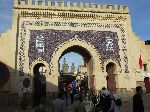 |
One of the main gates to the medina is Bab Boujloud. Beyond these gates is one
of the world's largest pedestrian zones, car-free area. It is blissfully, pretty
much free of motorcycles, which, in other Moroccan souks, are loud, squirrelly,
and intimidating. The Mauresque-Andalusian style gate (bab in Arabic) was constructed by the French in 1913, but the 12th-century original -- oriented with an indirect entrance to frustrate battering rams -- can still be seen next to it on the left (partially out of the photo). The lobed, horseshoe arches are decorated with Fassi blue tiles on the outside (left) for the sky and green tiles on the inside (right) for the forest. The tiles are patterned in the form of stars and swirls. Standing outside looking in, there are two minarets. The one on the right belongs to the crumbling 20th-century Sidi Lazzaz Mosque. The other minaret, topped by two golden orbs, is part of the recently restored, historic, 14th-century Bou Inania Medersa. |
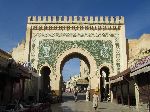 |
|
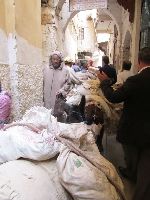 |
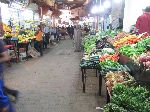
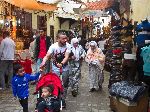
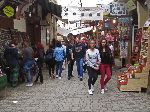
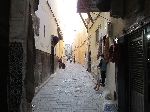 The are two parallel roads that run much of the length of the medina; Talâa Sghiro (the narrow ascending street) and Talâa Kbira (the wide ascending street). Life on Talâa Kbira tends to be of a bit scaled down and more residential than Talâa Sghiro. The sides of Talâa Sghiro is predominantly shops. It is fairly standard for them to be stocked from floor to ceiling with goods. |
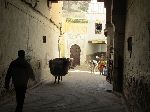 |
|
| If there is one of an item in the market there is likely to be at least a hundred others just like it. | |||
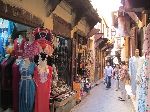 |
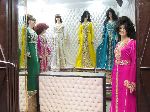
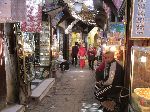
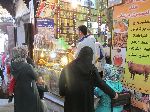
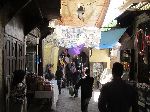 |
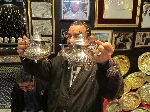 |
|
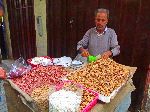 |
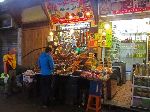
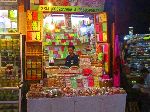
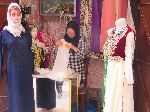
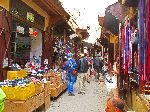 |
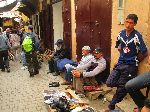 |
|
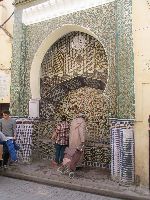 |
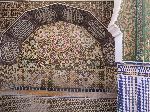 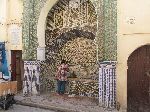 Fez
is also noted for its over 60 tiled public fountains. These were the source of piped in water
for many neighborhood and
water troughs for donkeys. As individual houses get direct water service some of
the public fountains have been turned off. Some still functioning but
are drab from lack of maintenance. But the best are gorgeous. Some of the most
beautiful are on Talâa
Sghiro and Talâa
Kbira. There are others tucked away in the neighborhoods. A local
association is now Fez
is also noted for its over 60 tiled public fountains. These were the source of piped in water
for many neighborhood and
water troughs for donkeys. As individual houses get direct water service some of
the public fountains have been turned off. Some still functioning but
are drab from lack of maintenance. But the best are gorgeous. Some of the most
beautiful are on Talâa
Sghiro and Talâa
Kbira. There are others tucked away in the neighborhoods. A local
association is now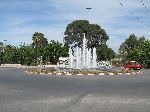 working to save and restore the fountains of Fez. working to save and restore the fountains of Fez.Fez is
continuing its association with water features, but the new ones are being
installed to enhance traffic circles (right). |
||
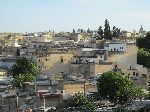 |
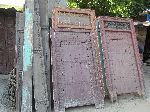 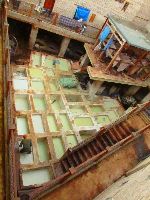 Fifty
meters northwest of Talâa Kbira is the Ain
Azliten neighborhood. It is one of the oldest district in the Fez medina, dating
to the early 9th century. Its name comes from an ain (water source)
bearing the name of an Amazigh (Berber) group, the Azliten. The quarter is
largely residential, with some light industry (small tannery (right), weavers) and
antique / recycler businesses. Fifty
meters northwest of Talâa Kbira is the Ain
Azliten neighborhood. It is one of the oldest district in the Fez medina, dating
to the early 9th century. Its name comes from an ain (water source)
bearing the name of an Amazigh (Berber) group, the Azliten. The quarter is
largely residential, with some light industry (small tannery (right), weavers) and
antique / recycler businesses. |
||
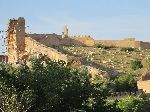 On
the hill, beyond Ain Azliten and outside of the city wall, is the Merinide
Necropolis (cemetery) and the tomb of Marinades. The Marinade Dynasty was a
Sunni Muslim dynasty of Zenata Berber descent, that ruled Morocco from the 13th
to the 15th century. This was the Golden Age of Fes history and probably gave
rise to both of city's nicknames, "Mecca of the West" and the "Athens of
Africa", are derived from this learned and dutiful history. On
the hill, beyond Ain Azliten and outside of the city wall, is the Merinide
Necropolis (cemetery) and the tomb of Marinades. The Marinade Dynasty was a
Sunni Muslim dynasty of Zenata Berber descent, that ruled Morocco from the 13th
to the 15th century. This was the Golden Age of Fes history and probably gave
rise to both of city's nicknames, "Mecca of the West" and the "Athens of
Africa", are derived from this learned and dutiful history. |
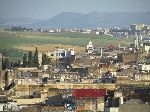 |
||
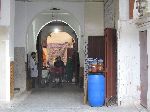 |
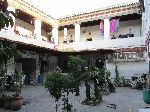 Qaât Smen Fondouk (The Butter Market) dates back to
at least the 17th century. The interior is most and the gallery is narrow. On
the ground floor you can buy rancid butter, honey, olive oil and Khliâ,
Fassi-style dried meat, which is cooked and preserved in animal fat. The second
floor houses leather and weaving workshops. Qaât Smen Fondouk (The Butter Market) dates back to
at least the 17th century. The interior is most and the gallery is narrow. On
the ground floor you can buy rancid butter, honey, olive oil and Khliâ,
Fassi-style dried meat, which is cooked and preserved in animal fat. The second
floor houses leather and weaving workshops. |
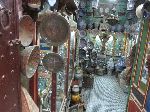 |
|
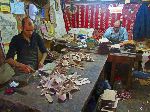 Tazi Fondouk is simple,
with the interior walls free of any decoration except for a few lobed-arches. It
has gone through many transformations. Today, on the ground floor leather
craftsmen fashion belghas (slippers for men), cherbils (slippers for women),
poof (foot cushions) and bags. The second floor has maintained it original
function as a temporary residence for visitors and traveling merchants. Tazi Fondouk is simple,
with the interior walls free of any decoration except for a few lobed-arches. It
has gone through many transformations. Today, on the ground floor leather
craftsmen fashion belghas (slippers for men), cherbils (slippers for women),
poof (foot cushions) and bags. The second floor has maintained it original
function as a temporary residence for visitors and traveling merchants. |
|||
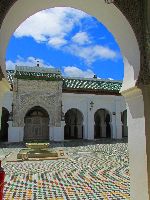 |
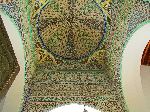 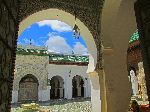 Qaraouiyine mosque is described as "the most emblematic landmark of the City of
Fez and a true icon of Moroccan architecture." It was founded in 859 by Fatima
Al Fihria, a pious woman from the holy city of Kairouan, Tunisia. Over the
centuries, as its reputation grew it became an import center of learning. It is
considered the first multidisciplinary university in the world. Some of the
distinguished scholars who studied and taught here are: Avempace (c. 1085 –
1138) and Averroes 1126 – 1198) (philosophers), Al Idrissi (1100 – 1165)
(geographer), Maimonides (c. 1135 – 1204) (Jewish doctor-philosopher), Ibn
Kaldoun (1332 – 1406) (historian), and Ibn Hirzihim (d. 1163), Abou
Madyane(1126–1198), and Abdeslam ben Machih (1140 – 1227) (mystics). Qaraouiyine
remains a center of Islamic spirituality. Non-believers can't enter, but it is
still very impressive from the door, and this is only a fraction of the 800
square meter complex.. Qaraouiyine mosque is described as "the most emblematic landmark of the City of
Fez and a true icon of Moroccan architecture." It was founded in 859 by Fatima
Al Fihria, a pious woman from the holy city of Kairouan, Tunisia. Over the
centuries, as its reputation grew it became an import center of learning. It is
considered the first multidisciplinary university in the world. Some of the
distinguished scholars who studied and taught here are: Avempace (c. 1085 –
1138) and Averroes 1126 – 1198) (philosophers), Al Idrissi (1100 – 1165)
(geographer), Maimonides (c. 1135 – 1204) (Jewish doctor-philosopher), Ibn
Kaldoun (1332 – 1406) (historian), and Ibn Hirzihim (d. 1163), Abou
Madyane(1126–1198), and Abdeslam ben Machih (1140 – 1227) (mystics). Qaraouiyine
remains a center of Islamic spirituality. Non-believers can't enter, but it is
still very impressive from the door, and this is only a fraction of the 800
square meter complex.. |
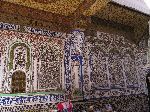 |
|
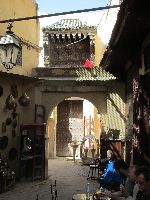 |


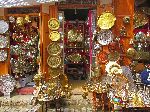
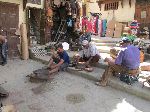 Seffarine Square dates back to the 9th century. It, a cacophony of coppersmiths and other metal workers, pounding out pots, pans, buckets, incense burners, trays, teapots, sugar boxes, food strainers, kettles, couscous steamers, samovars and more. The finished products are on display in the shops around the square (and throughout Fes). The skills are learned through apprenticeships. Seffarine gives it name to a nearby madrasa and hammam. |
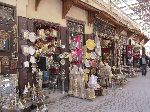 |
|
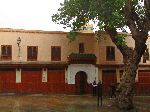 The Seffarine
Madrasa was built in 1270. It
is the oldest of the Merinid madrasah in Fez. The Merinid's madrasas were a
symbol of the Dynasty's attachment to Sunni orthodoxy. They were an
instrument for the
authorities to impose teachings that conformed to their political convictions
and assert the legitimacy. The prayer hall contains
what's thought to be the oldest mihrab in the city. The students rooms are
arranged around a rectangular patio, with a pool in the center. The Seffarine
Madrasa was built in 1270. It
is the oldest of the Merinid madrasah in Fez. The Merinid's madrasas were a
symbol of the Dynasty's attachment to Sunni orthodoxy. They were an
instrument for the
authorities to impose teachings that conformed to their political convictions
and assert the legitimacy. The prayer hall contains
what's thought to be the oldest mihrab in the city. The students rooms are
arranged around a rectangular patio, with a pool in the center. |
|||
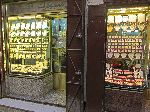 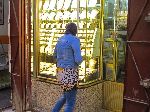 Similar
to the cluster of coppersmith, there is a cluster of jewelry shops. There always
seems to be a lot of people actively shopping in the jewelry souk. Similar
to the cluster of coppersmith, there is a cluster of jewelry shops. There always
seems to be a lot of people actively shopping in the jewelry souk. |
|||
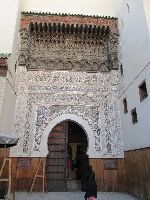 |
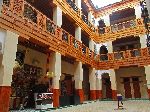 Fitting
for the carpenters souk, the façade of the
door to the foundouk at Nejjarine complex exhibits an abundance of craftsmanship.
Nejjarine name refers to the carpentry and other wood working that is the main
activity around the square. The foundouk (a historic traveler’s inn), is now
home to a carpentry museum. The entrance is made up of a wooden canopy, and an
arch that combines sculpted plaster bands with inlay and fields of multicolor zillij (tile). Inside, the interiors are decked out with
magnificent wood-carved balconies and sculpted pillars. The permanent exhibition
houses a collection of wooden arts, crafts, and carpentry tools, dating back as
early as the 14th century. Fitting
for the carpenters souk, the façade of the
door to the foundouk at Nejjarine complex exhibits an abundance of craftsmanship.
Nejjarine name refers to the carpentry and other wood working that is the main
activity around the square. The foundouk (a historic traveler’s inn), is now
home to a carpentry museum. The entrance is made up of a wooden canopy, and an
arch that combines sculpted plaster bands with inlay and fields of multicolor zillij (tile). Inside, the interiors are decked out with
magnificent wood-carved balconies and sculpted pillars. The permanent exhibition
houses a collection of wooden arts, crafts, and carpentry tools, dating back as
early as the 14th century.Near the entrance is the Nejjarine fountain, which is also admired for its craftsmanship (right). |
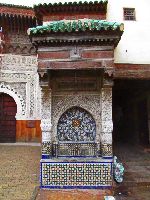 |
|
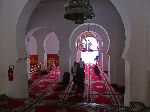 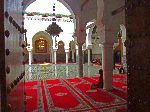 Generally
non-believers are not allowed in mosques in Morocco, but doors are often wide
open during pray times and there seem to be no restrictions on photography. It
is not unusual to see believers inside the mosque, pointing their cell phones at
the architecture and taking pictures. Generally
non-believers are not allowed in mosques in Morocco, but doors are often wide
open during pray times and there seem to be no restrictions on photography. It
is not unusual to see believers inside the mosque, pointing their cell phones at
the architecture and taking pictures. |
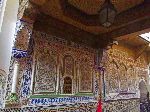 |
||
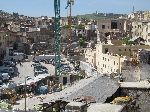 |
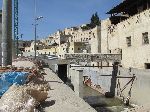 Place Lalla Yeddouna at the heart of the Medina is currently undergoing
reconstruction and preservation measures following a design competition
sponsored by the Millennium Challenge Corporation (Washington D.C.) and the
Government of the Morocco. The construction projects scheduled for completion in
2016 encompass historic preservation of particular buildings, construction of
new buildings that fit into the existing urban fabric and regeneration of the
riverfront. The intention is to not only preserve the quality and
characteristics of the UNESCO World Heritage Site but to encourage the
development of the area as a sustainable, mixed-use area for artisanal
industries and local residents. Place Lalla Yeddouna at the heart of the Medina is currently undergoing
reconstruction and preservation measures following a design competition
sponsored by the Millennium Challenge Corporation (Washington D.C.) and the
Government of the Morocco. The construction projects scheduled for completion in
2016 encompass historic preservation of particular buildings, construction of
new buildings that fit into the existing urban fabric and regeneration of the
riverfront. The intention is to not only preserve the quality and
characteristics of the UNESCO World Heritage Site but to encourage the
development of the area as a sustainable, mixed-use area for artisanal
industries and local residents.It was disturbing to see one man washing hides in the river. Not far away another man was at the river side with a jug of chemicals, wearing chemical resistant gloves and attending to a couple of large baskets of newly cast teapots that needed cleaning. It had all the makings of a poor outcome for water quality. |
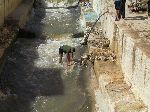 |
|
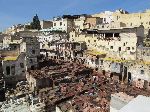 |
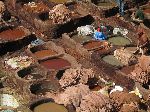
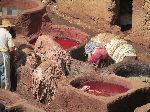
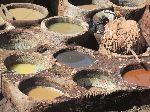
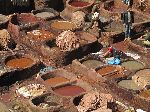 |
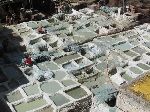 |
|
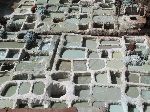
|
Chouara Tannery is the largest of four traditional tanneries still operating. It
is almost 800 years old. The tanneries process
the hides of cows, sheep, goats and camels, which are turned into high-quality
leather products such as bags, coats, shoes, and slippers in the surrounding
workshops. This is all achieved
manually, without modern machinery, and the process has barely
changed since medieval times. Between the colors, geometrics and men at work it
is mesmerizing to watch, a bit mind-boggling and disturbing to think about, and so odiferous you
can come close to passing out. Hides are first soaked in a mixture of cow urine,
quicklime, water, and salt. This caustic mixture helps to break down the tough
leather, loosen excess fat, flesh, and hair that remain on them. The hides are
soaked for two to three days after which tanners scrap away excess hair fibers
and fat in order to prepare the hides for dyeing. The hides are then soaked in
another set of vats containing a mixture of water and pigeon poop. Pigeon poop
contains ammonia that acts as softening agents that allow the hides to become
malleable so they can absorb the dye. (The pigeon poop and cow urine produce a stench so pungent that
the tour guide supply sprigs of fresh mint to visitors, to hold under their noses, to help them
endure the odor -- it works.) The hides are then laid out on the rooftops to
dry before dying. As one of the few, and perhaps regrettable, changes for the
times: The vegetable dyes -- poppy (red), turmeric (yellow), mint (green), indigo
(blue) -- have been replaced by industrial chemicals. The tanner uses his bare feet to knead the hides for up to three hours to achieve the desired softness. The hides are then placed in dying pits containing natural vegetable dyes, such as poppy flower (red), indigo (blue), henna (orange), cedar wood (brown), mint (green), and saffron (yellow). Other materials used for dyeing include pomegranate powder, which is rubbed on the skins to turn them yellow, and olive oil, which will make them shiny. Once the leather is died it is taken out to dry under the sun. The finished leather is then sold to other craftsmen who make the famous Moroccan slippers, known as babouches, as well as wallets, handbags, furniture and other leather accessories. |
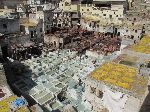
|
|
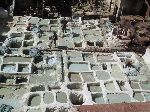 |
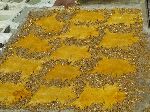
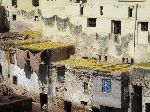 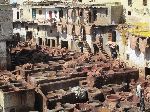
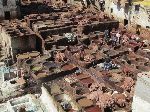 |
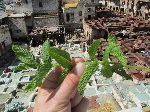 |
|
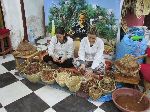 |
On the stretch of road between Essaouira and Marrakech, prickly-leaved argan trees span out to the horizon in every direction, thriving in the arid climate where few other plants could prosper. Argan oil is so versatile and valuable it’s likened to ‘liquid gold’. With a wide variety of uses, both culinary and cosmetic, and a long list of medicinal properties, the oil is an attractive commodity and the rest of the world is catching on to its healing benefits. Exports more than doubled in the last 5 years to 700 tons, Bloomberg reported in 2013, adding that growing demand had bumped up wholesale prices 50 percent since 2007, to $30 a liter. Retail prices can exceed 10 times that amount. Morocco’s argan forests cover about 800,000 hectares near the Souss Valley, an area framed by the Atlas Mountains, Atlantic Ocean, and the Sahara Desert, which hosts roughly 21 million trees and has been given UNESCO protection as a ‘biosphere reserve’. Argan husks are reportedly 16 times tougher than a hazelnut shell. Stories, dating back to the 13th century, explain that goats would eat the argan fruits, locals later collecting their droppings to retrieve the argan nuts, which had been conveniently softened by the animals’ stomach juices. This method saved on labor by making the kernels easier to salvage, but the resulting oil had a distinct stink to it. Today, argan oil production skips the goats’ intestines. The work is done with the hands of tireless women. Argan nuts must be cracked manually — attempts to mechanize the method have failed to keep the delicate kernels intact. It takes 30kg of argan nuts, roughly the annual yield of one tree and between 15 and 20 hours of hand processing to make 2 liters of cooking oil or 1 liter of cosmetic oil. The process of splitting the nuts to retrieve the oil-rich seeds is highly labor intensive and this, coupled with the rarity of the argan tree, explains why argan oil is the most expensive edible oil in the world. According to the International Development Research Centre (IDRC), argan trees support the livelihoods of 3 million Moroccans, about 10% of the country’s population, who use the husks as firewood, the fruit for animal fodder and the pips to make precious oil. Argan oil is an important economy for locals — particularly for women, who have grouped together to form more than 150 cooperatives. Chemistry professor and founder of Morocco’s first female-run argan collective, Zoubida Charrouf, told the IDRC that the women’s incomes have increased to about €6 a day, 10 times more than a few years ago. Argan oil has a multitude of uses: it can be drizzled over salads, couscous and tagines to add a nutty taste, applied as a scar healing, skin rejuvenating, nail strengthening and hair vitality treatment and used medicinally as an anti-inflammatory and to aid with immunity and blood circulation. No wonder Berbers call argan the ‘Tree of Life.’ |
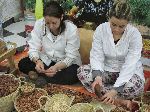 |
|
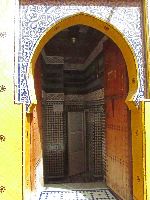 |
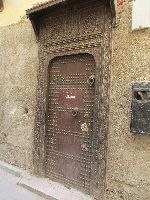 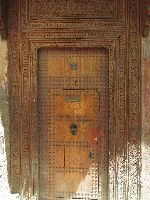
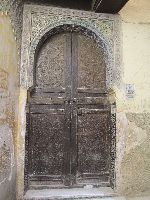
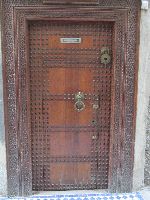 |
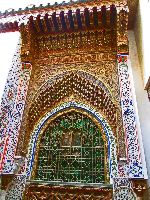 |
|
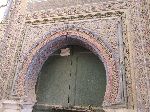 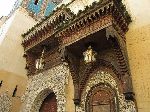 Like most old medina, Fez has some many well-crafted doors. In some towns they
distinguish themselves with color and style, Here the quality is in the
craftsmanship, carving, architecture and proportion. Like most old medina, Fez has some many well-crafted doors. In some towns they
distinguish themselves with color and style, Here the quality is in the
craftsmanship, carving, architecture and proportion. |
|||
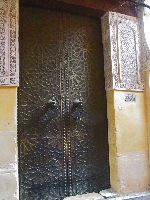 |
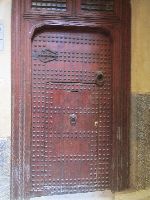
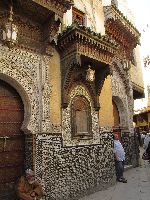
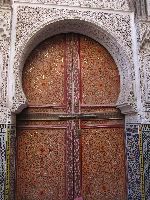
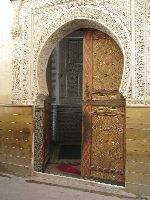 |
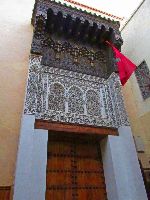 |
|
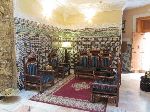 |
|
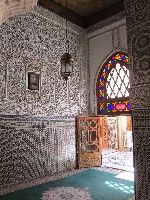 |
|
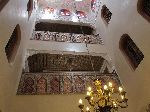
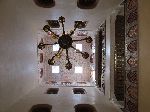
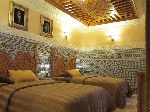
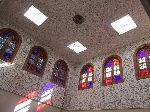 |
|||
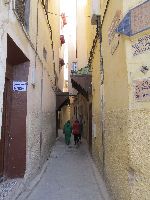 |
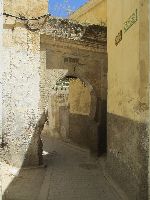
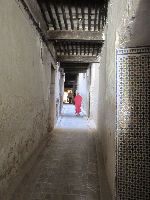
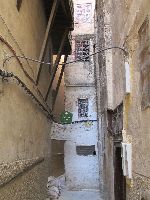
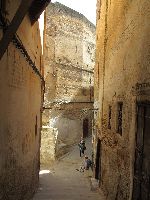 |
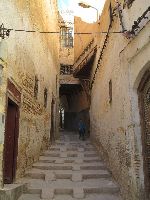 |
|
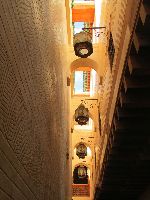 |
The streets of the old city dance along like architectural jazz with a thousand textures and shapes, and scarcely a parallel line or plain. |
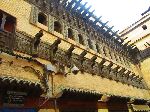 |
|
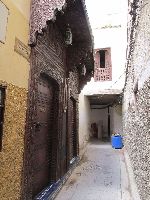 |
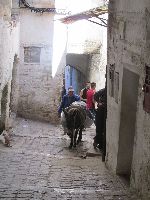
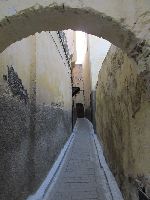
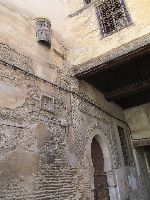
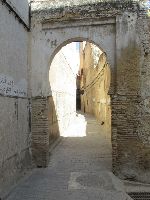 |
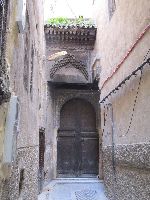 |
|
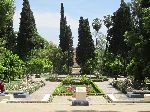 |
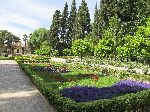 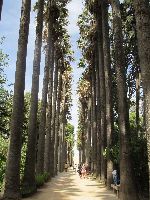 The
largest garden near the medina, Bou Jeloud share its name with
the nearby gate to the medina, and a former fortress built
by the Almoravids in the 11th-century. This 18th-century garden is considered
the "green lung" of the medina. In the 19th-century, it became an imperial garden
-- it is near the Royal Palace -- and was enclosed by a high wall. It was
reopened to the public in 1917. Arboreal species include giant bamboo, cedar,
pine, palm, orange, lemon, pomegranate, and myrtle, to name a few. The
largest garden near the medina, Bou Jeloud share its name with
the nearby gate to the medina, and a former fortress built
by the Almoravids in the 11th-century. This 18th-century garden is considered
the "green lung" of the medina. In the 19th-century, it became an imperial garden
-- it is near the Royal Palace -- and was enclosed by a high wall. It was
reopened to the public in 1917. Arboreal species include giant bamboo, cedar,
pine, palm, orange, lemon, pomegranate, and myrtle, to name a few. |
||
 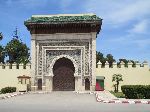 The
Royal Palace is not as big as it once was and some of the buildings of the
complex have been repurposed. Here are some of the gates around the Royal Palace
area. The
Royal Palace is not as big as it once was and some of the buildings of the
complex have been repurposed. Here are some of the gates around the Royal Palace
area. |
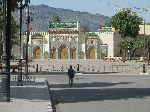 |
||
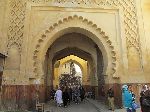 |
The Jewish quarter of Fez, the Mellah, was built near the royal residence in Fez Jdid,
in 1438. The Mellah, at first, consisted of Jews from
Fez el Bali and soon saw the arrival of Berber Jews from the Atlas range and
then Jewish immigrants from al-Andalus during the Inquisition of 1492. Bab Semmarine used to effectively separates the Jewish community of Fes from the rest of the world. It is another example of the sublime design and craftsmen of the Merinid Dynasty artisans. The wall and corridor feature several arches. The exterior gate has a main structural semicircular arch which is surrounded by a multi-lobe decorative arch. A band of geometrical knot work surrounds the gate. |
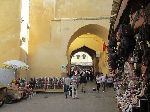 |
|
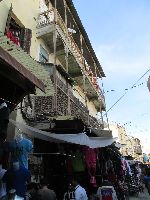 |
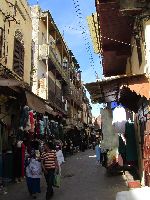 The Jewish community of Fes hasn't always fared well: In 1033, when Zenata
Berber Banu Ifran Chief Tamim conquered the city from the Zenata Berber Mahrawa,
6000 thousand Jews were killed in the Fez Massacre. In 1276, another massacre of
the Jews was fermented by the population, but it was stopped by the intervention
of the Merinid Emir. The Jewish community of Fes hasn't always fared well: In 1033, when Zenata
Berber Banu Ifran Chief Tamim conquered the city from the Zenata Berber Mahrawa,
6000 thousand Jews were killed in the Fez Massacre. In 1276, another massacre of
the Jews was fermented by the population, but it was stopped by the intervention
of the Merinid Emir.One of the distinguishing features of this Mellah is the buildings with balconies. In Moslem districts balconies are almost nonexistent and windows are covered with wood lattice so occupants can look out, but not be seen by the public (hiding the women). |
||
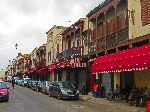 |
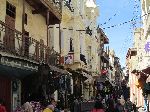
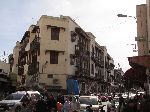
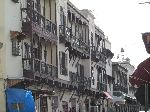
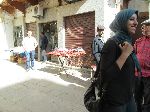 |
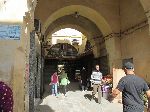 |
|
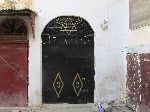 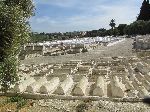 In
the Mellah, there are a couple of old synagogues, one of which has been restored. In
the Mellah, there are a couple of old synagogues, one of which has been restored.
Adjacent to the Mellah is a well maintained Jewish cemetery (left). |
|||
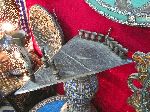 |
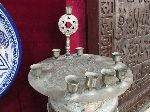
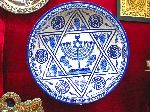
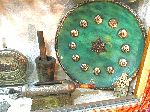
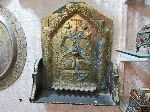 |
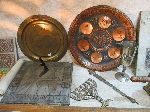 |
|
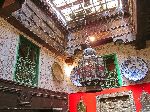 |
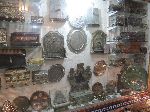 Because the residents of the Mellah
worked in the medina and they wanted a convenient place of worship midday, there
were also synagogues in the medina. Some of these have been converted into
antique shops / museums. Even sixty years after the majority of the Jewish
population left there is still a large inventory of Jewish objects in a half
dozen museum shops and antique shops. On display were menorah and other candle
holders, a variety of plates, boxes, doors, hands (protection against bad and
evil) and much more. Because the residents of the Mellah
worked in the medina and they wanted a convenient place of worship midday, there
were also synagogues in the medina. Some of these have been converted into
antique shops / museums. Even sixty years after the majority of the Jewish
population left there is still a large inventory of Jewish objects in a half
dozen museum shops and antique shops. On display were menorah and other candle
holders, a variety of plates, boxes, doors, hands (protection against bad and
evil) and much more. |
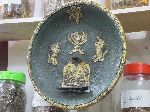 |
|
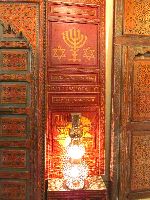
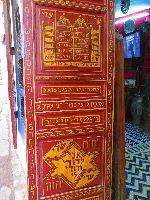
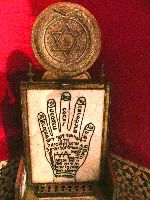
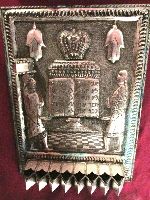 |
|||
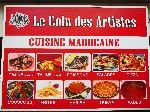 Eating al fresco, en plein air, or simply in the cool or outdoors, is very common
and popular in Fez. Besides the regular pop-and-water-stands, there were juice
bars (left), steamed snails (center) and sidewalk tables for cafés
and restaurants. Generally, the temperatures were more comfortable and the people
watching more interesting. Eating al fresco, en plein air, or simply in the cool or outdoors, is very common
and popular in Fez. Besides the regular pop-and-water-stands, there were juice
bars (left), steamed snails (center) and sidewalk tables for cafés
and restaurants. Generally, the temperatures were more comfortable and the people
watching more interesting. |
|||
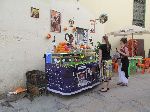 |
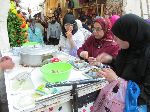
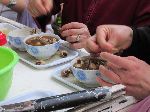
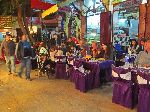
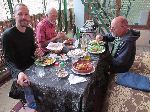 |
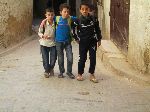 |
|
| Sefrou
|
|||
|
|
|||
|
|
Unique Programs To Special Places For Memories Of A Lifetime!
"Hosted by
DreamHost - earth friendly web hosting"
|
|
